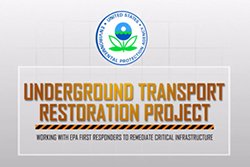Homeland Security Research Program Videos
Below are links to relevant research and tools which support ESAM. EPA’s Homeland Security Research Program (HSRP) has developed videos to highlight sampling and analysis research.
EPA's emergency response and homeland security research provides science and technology needed to effectively respond to and recover from disasters.
HSRP Models, Tools and Applications provide innovative models, tools, and technologies to aid in making informed decisions related to human health and the environment.
Homeland Security Research Program Videos

Bio-Response Operational Testing and Evaluation (BOTE)
HSRP and Federal Partners conducted the BOTE project in order to test and evaluate three decontamination technologies in an indoor setting for a biological incident. Samples were collected before and after decontamination using several sampling techniques. The samples were then analyzed to determine efficacy of the decontamination method.
Read more about the BOTE project.

Underground Transport Restoration Project (UTR)
DHS and EPA’s HSRP conducted the UTR project in an underground transport system (subway) setting in order to test and evaluate sampling methods and decontamination technologies that might be used for a wide-area biological incident. Sample processing and analysis methods were also developed and tested for unique sample types.
Read more about the UTR project.

Analysis for Coastal Operational Resiliency (AnCOR) Program
The Analysis for Coastal Operational Resiliency (AnCOR) program is an interagency collaboration between the Environmental Protection Agency (EPA), Department of Homeland Security, and the United States Coast Guard (USCG). The purpose of this program is to prepare the United States to respond and mitigate a wide-area release of a biological agent affecting USCG facilities and assets. In May 2022, a field-scale remediation of outdoor areas contaminated with a Bacillus anthracis surrogate was conducted as part of the AnCOR program. This wide area demonstration (WAD) exhibited capabilities and aided in the development of strategic guidelines.
Read more about the Wide Area Demonstration.
